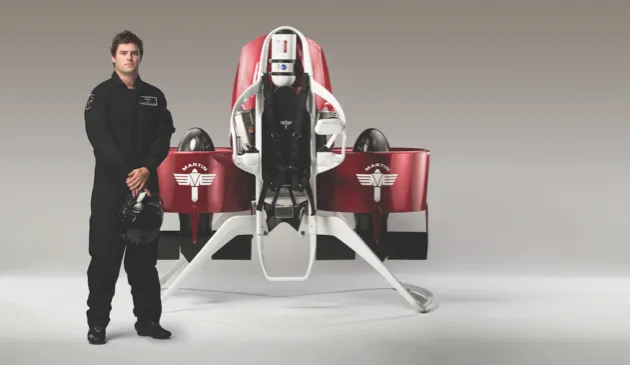Jetman Wing
For daredevils looking for the thrill of speed and the freedom of unencumbered flight, nothing can beat a personal jetpack. Powered by four miniature jet engines, this wing unit developed by Swiss pilot and aviation enthusiast Yves Rossy fits the bill. It can hit speeds of up to 300km/h (186mph) and is manoeuvrable enough to pull off loops and rolls.
Launched from a helicopter, the wings are guided entirely by the pilot’s body movements – there are no rudders, ailerons, or flaps. A throttle attached to the right hand controls thrust; the only other instruments are an altimeter to report altitude and a timer to keep track of fuel. There’s enough fuel to fly for around 10 minutes, after which Rossy is able to land safely using a parachute.
Protected from the engine exhaust by a heat-resistant suit, Rossy manoeuvres the carbon-fibre wings by tilting his head and angling his shoulders. It takes a lot of concentration to avoid an uncontrolled spin, “I stay relaxed, avoiding any fast movements, like a ski-jumper,” says Rossy.
In the event of a spin, the wing unit can be separated from the pilot, allowing both to independently parachute to safety.
Rossy unveiled his invention to the world in a flight over the Swiss Alps in May 2008. Four months later, he made history by using the jet-powered wings to cross the English Channel 99 years after Louis Blériot’s famous flight. Last November he could be seen flying around Mount Fuji, circling the volcano nine times over the course of a week (see video below).
Don’t expect to see this wing unit in stores anytime soon, though. Difficult to use and expensive to develop, it’s likely to remain one of a kind for the moment.
Martin Jetpack
Though its makers claim to have built ‘the world’s first practical jetpack’, the Martin Jetpack is actually powered by a pair of ducted fans, not a jet engine. Constructed from advanced lightweight composites, it’s the culmination of over 30 years of research by founder Glenn Martin, who started the project in his garage on a budget of just NZ $20 (£10) per month.

The Martin Jetpack has been designed with an emphasis on safety and ease of use. It can cruise at 56km/h (35mph) for up to 30km, and includes a specially designed parachute that is fired from a casing in case of failure. Protected by a Kevlar roll cage, the pilot controls pitch and roll with one hand and throttle and yaw with the other. “We are finding that even without flying experience, individuals are able to learn to fly the Jetpack in under five hours,” said Peter Coker, CEO of Martin Aircraft.
The company is already accepting orders, with a target launch date of mid-2014 for police and other government agencies. Sales to private individuals are expected to start in 2015, though the US $100,000 price tag means that it will remain the preserve of the lucky few for a while yet.
In this demo flight, the Martin Jetpack was flown to a height of around 1500m (5000ft)
Flying Bike
The scene in the film E.T. when Elliott takes flight on his bike, iconically silhouetted in front of a full Moon, could become a reality. That is if a crack team of engineers have their way. Their flying bicycle uses six electrically powered propellers: two large pairs over the wheels providing lift, and smaller ones on either side for manoeuvring and balance. Inspired by science fiction novels, the Czech companies Duratec, Technodat and Evektor, assisted by French company Dassault, launched the project in 2011. The first prototype was unveiled last June.
Although the bicycle carried a dummy during its remotely controlled demo flight, the team is hoping to test it with a human rider in 2014 and is working to add a control unit. Unfortunately, it only flies for five minutes before the battery runs dry.
This limited prototype is just the first step towards the team’s lofty goal. Their aim is to build a unit that works like a normal bike but can also take off for short, low-altitude flights, hopping over traffic or other obstacles. “We are still considering major changes,” said Technodat engineer Jindřich Vítů, who stressed that the bike is “a proof of concept”.
According to Vítů, a version that can be flown by a human will be ready in a year. If you’re impatient to fly something before then, check out the Flyke from Germany company Fresh Breeze, a recumbent tricycle equipped with a paragliding wing and a motor drive.
Follow Science Focus onTwitter,Facebook, Instagramand Flipboard